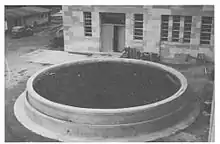University of Queensland Seismology Station
The University of Queensland Seismology Station was established in 1938 at the University of Queensland, Brisbane, Australia.[1]

History
The University of Queensland Seismology Station is a long term research project of the University, second only to the Pitch Drop experiment. The station was established following the Gayndah earthquake of 12 April 1935.[2] W.H. Bryan, who was a lecturer in Geology at the University of Queensland, undertook an investigation into the earthquake, distributing a questionnaire to those affected by it, and undertook field investigations.[3] This was done to establish the epicentre of the earthquake, and its cause and effects. Newspaper coverage of the event was extensive in 1935, and following on from an interview with W.H. Bryan, a donor presented a Milne-Shaw Seismograph to the University to aid their continuing research.[4] A second seismograph was loaned to the University by the Commonwealth Council for Scientific and Industrial Research (CSIR) and the University purchased several more.[5] An official station was set up in the basement of a building at the University of Queensland, then in George Street, Brisbane. It was designed to monitor tremors.
The Geology department of the University of Queensland, was led by Professor H.C. Richards from 1911-1947. Both Richards and Bryan made use of the public's interest in the 1935 earthquake to push for further research into earthquakes in Queensland and overseas.[6][7] They also had a role to play in cyclone prediction.[8] After the University moved to it new location in St Lucia, Brisbane in 1951, the existing seismographs, and in time new models, were re-housed in the basement levels of the new Richards Building,[9] but the near constant construction of new buildings at St Lucia, played havoc with the readings. Eventually the seismographs were removed to new observatories at Mt Nebo[10] in 1956 and Charters Towers in 1960.[11]
Collaboration with other bodies
The University of Queensland continues to monitor the seismograph network established with the original seismographs in 1935 and informs national and international networks of the results it retrieves. In 1970, the Queensland government Department of Mines and Energy became involved with the monitoring of seismic activity. Their participation ended in 1994, and the Advanced Centre for Earthquake Studies (now Earth Systems Science Computational Centre)[12] at UQ was formed to continue to analyse the impact of earthquakes in Queensland.[13] The United States Geological Survey's Global Seismographic Network have a collection of seismograms from Queensland.[14] The International Seismological Centre in the U.K. also collects data from Queensland.[15] Geoscience Australia maintains a national network of observatories collecting seismic data.[16]
References
- Heywood), Bryan, W. H. (Walter (1 January 1938). "The establishment of a Seismological Station in Brisbane, Queensland". espace.library.uq.edu.au. Retrieved 1 March 2016.
- Bryan, W.H. and Whitehouse, F.W. (1938). "The Gayndah earthquake of 1935" (PDF). Proceedings of the Royal Society of Queensland. 49 (10): 106–119. Retrieved 1 March 2016.
- Bryan, W.H. (1942). "Seismology in Queensland". Australian Journal of Science. 4: 144–146.
- "SEISMOGRAPH FOR QUEENSLAND - Anonymous Gift to University - The Courier-Mail (Brisbane, Qld. : 1933 - 1954) - 25 Apr 1935". Trove. Retrieved 1 March 2016.
- "Queensland University. - PURCHASE OF SEISMOGRAPH. LONDON, Thursday. - The Western Champion (Barcaldine, Qld. : 1922 - 1937) - 6 Jul 1935". Trove. Retrieved 1 March 2016.
- "AN EARTHQUAKE SENTINEL - Seismograph for Queensland - The Courier-Mail (Brisbane, Qld. : 1933 - 1954) - 9 Jul 1935". Trove. Retrieved 1 March 2016.
- "Earthquake Recorded. - AT QUEENSLAND OBSERVATORY. FIRST OPERATION OF SEISMOGRAPH. - Daily Mercury (Mackay, Qld. : 1906 - 1954) - 3 Jun 1937". Trove. Retrieved 1 March 2016.
- "Our £6000 watchdog is on the lookout for cyclones - PAGE 2 PEEP INTO AN EERIE". Trove. Retrieved 1 March 2016.
- Jones, Owen A. (1953). "Bulletin of the Seismological Society of America 43: 247-254" (PDF). THE NEW UNIVERSITY OF QUEENSLAND SEISMOLOGICAL STATION. Seismological Society of America. Retrieved 1 March 2016.
- "ESSCC Seismological Observatory-BRSA Mt Nebo Seismograph Station". www.quakes.uq.edu.au. Retrieved 1 March 2016.
- "Seismic Network Operations". earthquake.usgs.gov. Retrieved 1 March 2016.
- "ESSCC Seismological Observatory". www.quakes.uq.edu.au. Retrieved 1 March 2016.
- "Observatories in Australia – Seismology Research Centre". www.src.com.au. Retrieved 1 March 2016.
- "Global Seismographic Network". earthquake.usgs.gov. Retrieved 1 March 2016.
- "International Seismological Centre". www.isc.ac.uk. Retrieved 1 March 2016.
- "ANSN Seismic Data Repository". www.ga.gov.au. Retrieved 1 March 2016.
